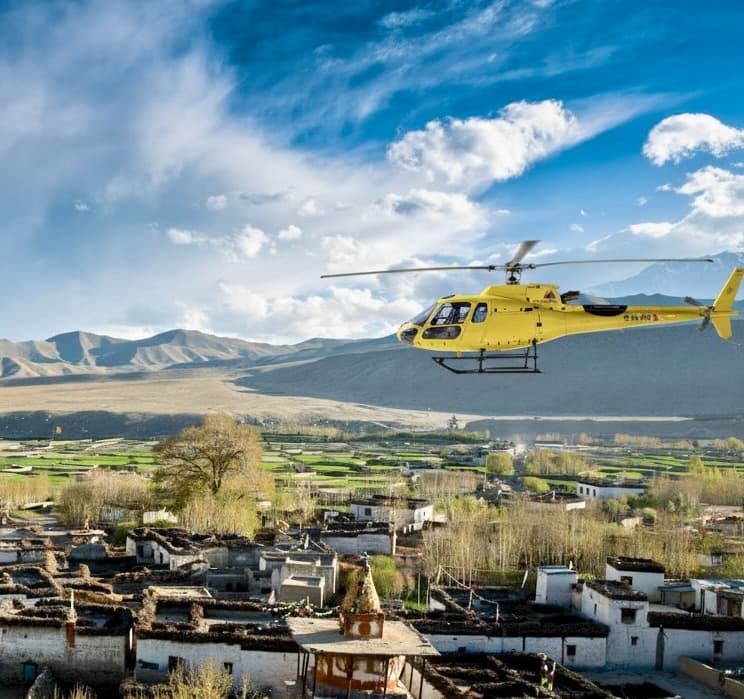The Luxury Annapurna Experience invites you to explore the best of Nepal in unparalleled style and comfort. Begin in the vibrant city of Kathmandu, where ancient temples, palaces, and bustling markets offer a rich tapestry of culture and history. Enjoy a guided tour of UNESCO World Heritage Sites before taking a scenic flight to Pokhara, known for its tranquil lakes, breathtaking mountain views, and laid-back charm. This exclusive journey combines luxurious accommodations, private transfers, and attentive service, ensuring a seamless and enriching experience in every destination.
(For Group rates and discounts please contact us at - Direct Call: +977-9851005129 (Nepal) and +1 916 794 8443 (USA) / Whatsapp: +977-9851005129 )
From Pokhara, embark on a remarkable trek through the lush landscapes of the Annapurna region. Traverse picturesque villages, terraced fields, and rhododendron forests, staying in select luxury lodges that offer warm hospitality, comfort, and stunning mountain views at every stop. With expert guides and thoughtfully curated itineraries, this adventure perfectly balances immersive trekking with well-deserved relaxation, allowing you to savor the beauty of the Himalayas in comfort and style. This journey is ideal for travelers seeking both the thrill of nature and the indulgence of luxury.
Major Highlights of the Luxury Annapurna Experience
- UNESCO World Heritage Tour in Kathmandu: Guided sightseeing in Kathmandu’s culturally rich landmarks, including Pashupatinath Temple, Swayambhunath Stupa, and the ancient Durbar Squares, offering a glimpse into Nepal’s vibrant history and spiritual traditions.
- Scenic Flight to Pokhara: Enjoy a short, breathtaking flight with views of the Himalayan range, landing in the serene lakeside city of Pokhara, known for its peaceful ambiance and majestic mountain backdrop.
- Luxury Stays in Kathmandu & Pokhara: Stay in top-tier accommodations, including renowned hotels like Kathmandu Marriott Hotel and Temple Tree Resort & Spa, ensuring comfort and relaxation throughout the journey.
- Trekking in the Annapurna Region: Trek through diverse landscapes, from lush forests and terraced fields to charming Gurung villages, surrounded by panoramic views of the Annapurna and Machapuchare peaks.
- Exclusive Mountain Lodges: Rest in handpicked luxury lodges at each stop along the trail, with warm hospitality, cozy rooms, and gourmet meals, making for a comfortable retreat after each day’s trek.
- Guided Pokhara Valley Tour: Explore Pokhara's scenic spots, including Phewa Lake, Davis Falls, and the International Mountain Museum, with stunning views and insight into the city’s unique character.
- Personalized Service & Expert Guides: Enjoy private transfers, a government-licensed guide, and expert trekking support for a seamless and safe adventure, tailored to ensure an unforgettable luxury experience.
- Farewell Dinner with Cultural Performance: Conclude your journey with an authentic Nepali farewell dinner in Kathmandu, featuring traditional cuisine and a vibrant cultural dance performance.
This carefully crafted itinerary combines cultural immersion, natural beauty, and luxury accommodations, creating a once-in-a-lifetime Himalayan adventure for discerning travelers.
Route Overview
The Luxury Annapurna Experience begins in Kathmandu, where you’ll explore the city’s cultural heritage with guided visits to iconic UNESCO World Heritage Sites. A scenic flight takes you to Pokhara, a lakeside gem surrounded by mountains. After a relaxing evening in this tranquil city, you’ll drive to Nayapul to begin your trek into the Annapurna region, starting with a scenic hike to Birethanti. From here, each day’s trek leads you through lush forests, terraced fields, and traditional Gurung villages, including charming stops at Ghandruk and Landruk. Staying in exclusive mountain lodges, you’ll enjoy warm hospitality, delicious meals, and breathtaking views of the Annapurna and Machapuchare peaks.
After reaching Majgaon, the trek continues to Lumle, followed by a private transfer back to Pokhara. The next day, you’ll explore Pokhara’s highlights with visits to Phewa Lake, Davis Falls, and the World Peace Pagoda. Your journey concludes with a flight back to Kathmandu, where you’ll enjoy a farewell dinner featuring authentic Nepali cuisine and a cultural performance. This thoughtfully crafted itinerary offers the perfect blend of luxury, adventure, and cultural immersion, providing a one-of-a-kind Himalayan experience for discerning travelers.
Alternative Tours
We also offer the following luxury trekking experiences in Nepal, designed to deliver premium service, comfort, and breathtaking Himalayan landscapes:
Luxury Everest View Trek - 8 Days: Discover the beauty of the Everest region on this short trek, with luxury stays and views of the world’s highest peaks.
Luxury Everest Base Camp Trek - 15 Days: Experience the classic trek to Everest Base Camp with upgraded accommodations and exclusive service along the way.
Upper Mustang Heli Trek with Luxury Accommodations in Kathmandu and Pokhara - 14 Days: Explore the remote and mystical Upper Mustang region, combining trekking and scenic helicopter flights for a unique adventure.
VVIP Everest Base Camp Luxury Trek - 10 Days: For discerning travelers, this VVIP trek offers exclusive services, luxurious accommodations, and a personalized experience to Everest Base Camp.
Everest Heli Trek with Kalapathher Landing - 9 Days: A luxury trek with a scenic helicopter return, including a special landing at Kala Patthar for incredible close-up views of Everest.
Ghorepani Poon Hill Trek - 10 Days: A picturesque trek to Poon Hill, perfect for those seeking stunning sunrise views of the Annapurna range with luxury lodges.
Langtang Valley Trek - 11 Days: Discover the serene beauty of Langtang Valley, enriched by cultural insights and luxury accommodations throughout.
Annapurna Base Camp Trek - 10 Days: Trek to Annapurna Base Camp with carefully selected accommodations and services, blending adventure with comfort.
If you need any further information, please contact us by email: at [email protected], Phone: +977- 985 100 5129 (WhatsApp)

































